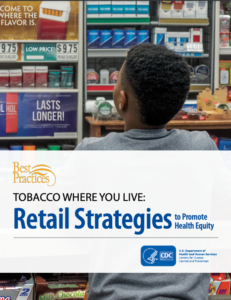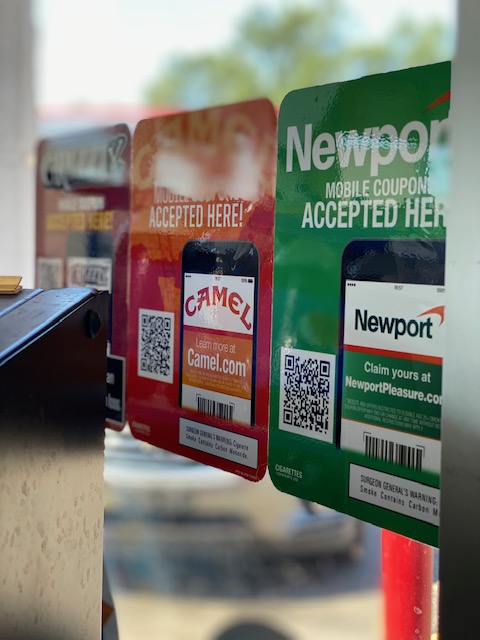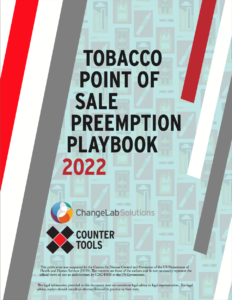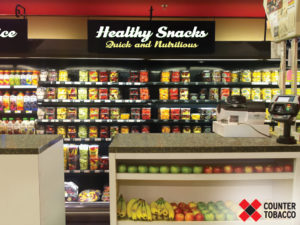Below are advances in point-of-sale tobacco control that we’ll be keeping an eye on in 2024. Click the links below or scroll to learn more:
- A Focus on Health Equity in POS Tobacco Control
- Comprehensive Bans on the Sale of Flavored Tobacco Products
- Tobacco Retailer Licensing
- Point-of-Sale Pricing Policies
- A Changing Tobacco Product Landscape
- Endgame Strategies
- Battles over Preemption
- Partnerships to Create Healthier Places: Tobacco, Food, Alcohol, Cannabis, and Physical Activity
1. A Focus on Health Equity in POS Tobacco Control
The United States has steadily expanded tobacco protections since 1964, resulting in less smoke in the air and fewer advertisements of tobacco products. However, these protections, which most Americans now take for granted, are not evenly distributed across the country or even across neighborhoods.
The availability and marketing of commercial tobacco products on a neighborhood level impact these disparities. Data from the 500 largest cities in the United States shows that census tracts with the highest smoking rates are also the ones with a greater density of tobacco retailers. These census tracts, which generally face multiple disadvantages, are also the ones with lower median household incomes and a greater proportion of people of color. [1]
The tobacco industry also targets specific demographic groups through tailored marketing tactics; bright candy-like packaging and an array of flavors appeal to youth while ads depicting rugged cowboys and hunters appeal to rural populations. As well, the industry, on countless occasions, has exploited Native American images on commercial tobacco products, a tactic used to encourage Native American use while also portraying tobacco products as more ‘natural’ to other communities.
A critical assessment of these manipulative tactics helps explain why, despite the overall US smoking rate decreasing to 11.5%, rates are much higher among people with lower levels of income and education, people who identify as American Indian/Alaska Native, men, people who identify as LGBTQ, people facing mental illness and disabilities, people who are uninsured or on Medicaid, and people living in the South and Midwest.

Fortunately, there are evidence-based and promising pro-equity solutions at the point of sale. Retail strategies can advance health equity by limiting access to and availability of commercial tobacco products, reducing exposure to tobacco marketing, and promoting cessation. The CDC’s supplement to the Best Practices User Guides Tobacco Where You Live: Retail Strategies to Promote Health Equity can help you:
- Understand the local retail environment
- Implement commercial tobacco retail strategies equitably
- Learn how communities have used retail strategies to advance health equity
- Identify the best resources and tools to get started.
Read on below to learn how strategies like raising tobacco prices (trend #4), banning the sale of menthol cigarettes and all other flavored tobacco products (trend #2), and reducing tobacco retailer density (trend #3) can work to reduce disparities and improve health equity.
Health equity can and should be considered as part of any tobacco control policy, including equitable enforcement, and we expect this to continue becoming standard practice in 2024.
The FDA Center for Tobacco Products’ 5-year strategic plan, released at the end of 2023, includes health equity as one of four key themes.
Localities can consider conducting a health equity impact assessment to determine what the results of any given policy may be on the ground. An approach considering social determinants of health can help practitioners ensure that a policy’s benefits reach all populations and that resources and services are distributed consistently and equitably across these populations so as not to exacerbate existing disparities.[9]
2. Comprehensive Bans on the Sale of Flavored Tobacco Products
W e know that youth are more likely to initiate tobacco use with a flavored or menthol tobacco product. We also know that menthol products are easier to start and harder to quit. Scientific reviews and publications have time and again concluded that their removal from the market would benefit public health. Banning the sale of menthol cigarettes and all other flavored tobacco products also has significant potential to improve health equity given the tobacco industry’s decades of targeted marketing of these products to African American and other marginalized communities and the resulting disproportionate harm that these communities have faced. Learn more in our evidence summary on menthol.
e know that youth are more likely to initiate tobacco use with a flavored or menthol tobacco product. We also know that menthol products are easier to start and harder to quit. Scientific reviews and publications have time and again concluded that their removal from the market would benefit public health. Banning the sale of menthol cigarettes and all other flavored tobacco products also has significant potential to improve health equity given the tobacco industry’s decades of targeted marketing of these products to African American and other marginalized communities and the resulting disproportionate harm that these communities have faced. Learn more in our evidence summary on menthol.
While the FDA submitted rules prohibiting menthol cigarettes and flavored cigars to the White House for final review in October 2023, the Biden administration has delayed finalizing the rules until at least March 2024. The latest delay in action is unacceptable and prolongs the 45,000 Black lives lost to tobacco-related illness each year.
These rules will be a major step forward for public health, health equity, and the commercial tobacco endgame. However, even once finalized, implementing these rules could still take years, especially with likely tobacco industry litigation. State and local action to prohibit the sale of menthol cigarettes and all other tobacco products remains critical and can save lives and prevent addiction now. In 2024, we’ll be looking forward to more comprehensive policies prohibiting the sale of all flavored tobacco products, including menthol cigarettes, at the local and state level.
Flavored e-cigarettes also remain a concern as a key driver of youth e-cigarette use. While the FDA prohibited flavors other than menthol or tobacco in cartridge-based “pod mod” e-cigarettes like Juul in January 2020, flavored disposable e-cigarettes and flavored e-liquids used in tank and mod style e-cigarettes remain on the market (most illegally given their lack of authorization under the FDA’s premarket review process). Data has shown that youth use of types of e-cigarettes not covered by the sales ban have skyrocketed, and use of flavors in products for which the restrictions apply have just shifted to menthol, underscoring that youth will use whatever flavors are available.
In 2023, we saw continued progress with now at least 375 localities across 12 states restricting the sale of flavored tobacco products, with an increasing number that include all retailers and all flavors. While the tobacco industry continues to fight these policies with delay tactics, forcing them to referendum (seen in California, and also in Washington County, OR) and challenging them in court (as seen in Edina, MN), the tobacco industry has not won any of these cases to date.
There are already proposals to ban the sale of all flavored tobacco products at state level in 2024 many places, including Vermont and Hawaii. Look for more to come as the year goes on!
Learn more about flavored tobacco products and menthol tobacco products in our evidence summaries.
3. Tobacco Retailer Licensing
Tobacco retailer licensing (TRL) is a versatile regulatory tool that can be used to implement a range of policies. In its simplest form, a TRL policy requires stores that want to sell tobacco products like cigarettes, cigars, smokeless tobacco, and e-cigarettes to obtain a license from the city, county, and/or state. Strong TRL ordinances require retailers to pay an annual fee to obtain or renew their license that covers the cost of administration and enforcement of the license, including regular inspections. Research has shown strong TRLs can help reduce youth initiation and use of tobacco products, including e-cigarettes.10]
Licensing also allows for more accurate tracking of all tobacco retailers in a given geography, including e-cigarette retailers and vape shops, and can serve as a platform on which to build other regulations that can have a large impact on the community environment, such as restricting the density, type, and location of tobacco retail outlets (e.g. no licenses can be issued to retailers at stores near schools). The potential for license suspension or revocation as a consequence for violations encourages retailers to comply with tobacco control law more than fines, which some may see as the cost of doing business.
In 2023, many local jurisdictions made strides in implementing or strengthening licensing requirements, including many in Ohio (e.g. Lorain, Oxford, Hamilton), California (e.g. Stockton, Concord, Humboldt County, Bakersfield), as well as Massachusetts (e.g. Pittsfield). Local licensing policies are also the foundation for effective enforcement for local policies banning the sale of flavored tobacco products and of many endgame policies as well.
Despite the major benefits of licensing for tracking retailers, ten states still lack any licensing requirement for tobacco retailers at the state level. There’s plenty of work to do in 2024, both for the remaining states without licensing and for strengthening some existing licensing laws that lack adequate funding to be effective. See the American Heart Association’s Tobacco Retail Licensure interactive map for more on each state’s licensing provisions. In addition, with 8 states that have yet to update their laws to match the federal minimum legal sales age of 21, there are opportunities for states to update their laws to include licensing and/or strengthen their current licensing laws at the same time. Licensing is also a key mechanism for ensuring that enforcement for tobacco control policies is focused on retail sales rather than on underage youth purchases. Learn more about Tobacco 21 best practices here and see state Tobacco 21 grades here to see how they align with best practices, including enforcement through licensing. Learn more about equitable enforcement of tobacco control policies here.
Mapping can help communities determine the impact of any given TRL policy on the ground, for example, by helping to provide visual evidence displaying the number of tobacco retailers currently located near schools in their town or disparities in tobacco retailer density rates in their community. Mapping can also help determine what TRL “plug-ins” might have the most impact on the tobacco retail environment in their community.
4. Point-of-Sale Pricing Policies
Raising tobacco prices is one of the most effective strategies for reducing initiation, decreasing consumption, and increasing cessation of tobacco products.[2] Additionally, this strategy can help reduce tobacco use among low-income groups and reduce socioeconomic disparities in smoking; in fact, one study found that increasing tobacco prices was the only policy option of those assessed to show a significant pro-equity effect.[3] Point-of-sale pricing policies are innovative tobacco control solutions that can reduce health disparities, counteract industry targeting, and encourage people who smoke to quit. Prices can be increased through excise taxes and through other policies such as establishing minimum “floor” prices and prohibiting coupon redemption and discounts on tobacco, which can help prevent the tobacco industry from circumventing the effects of tax increases.[12]
Three states (Rhode Island, New York, and New Jersey) prohibit discounts on tobacco and the redemption of coupons. As states look to raise excise taxes on tobacco, they can also consider minimum floor prices and prohibiting discounts at the same time in order to keep prices high, as recent research suggests is needed.[13] For example, Colorado’s tax increase that voters approved in 2020 also set a minimum floor price of $7/pack of cigarettes, which will rise to $7.50 in 2024.

On a local level, more places are also considering minimum floor prices and price discounting bans. In 2024, Minneapolis may follow in the footsteps of twin city St, Paul, MN in prohibiting discounts for all tobacco products and setting minimum prices for both cigarettes and smokeless tobacco products. Price discount bans and minimum pricing policies have also been implemented in several other localities in New York, California, Minnesota, and Massachusetts.
Minimum price policies that also prohibit the use of price promotions (e.g. coupons, multi-pack discounts) could help reduce socioeconomic disparities in smoking by raising the price of discount brands, which may encourage more people who are lower-income and smoke to quit. [14] However, these policies should also be paired with increases in the availability of cessation resources and targeted outreach to low-income communities. Strong minimum price laws can also prevent price manipulation by geographic area or by brand, thereby reducing targeting of products to certain populations. Models estimate that prohibiting price promotions across the US could reduce smoking rates by 13%, [15] and establishing a national minimum price of $10 per pack of cigarettes could reduce cigarette sales by 5.7 billion packs per year and result in 10 million people quitting.[16] Learn more about raising the price of tobacco through non-tax approaches
5. A Changing Tobacco Product Landscape
In 2024, we will continue to see changes, both large and small, to the tobacco product landscape. Here are the changes we’ll be watching this year:
Premarket Review: As the FDA wades through the backlog of products (both with tobacco-derived and non-tobacco nicotine) with submitted applications for premarket review, we’ll continue to see changes in the mix of e-cigarette and oral nicotine products on the market. At this point, all new products that were not on the market prior to the 2016 “deeming rule” and which have not received marketing authorization from the FDA should no longer be on the market (though that’s not the case in reality). As of January 2024, the agency has only authorized the marketing of 23 e-cigarette products and even fewer other tobacco products. They report having ruled on more than 99% of the nearly 26 million deemed products that submitted premarket applications. However, they also reported to a federal court in January 2024 that while they have taken action on 91% of applications for the most popular e-cigarette products, they will not finish reviewing those applications until June 30, 2024, which is nearly three years after their original deadline. We look forward to seeing them take action on these products.
In 2023, the FDA also:
- Granted premarket authorization for three versions of Marlboro HeatSticks, to be used with iQOS heated tobacco products.
- Denied marketing authorization several menthol e-cigarette products, including two Vuse menthol e-cigarette products, two Vuse Solo menthol e-cigarettes, and myblu menthol e-cigarettes, as well as six other-flavored Vuse Alto e-cigarette products and over 250 flavored and tobacco-flavored e-liquids. Also in early 2024, they denied marketed authorization for 22 Smok, Sourin, and blu brand e-cigarette products, which have been popular with youth.
- Worked with Customs and Border Protections to seize unauthorized products, such as Elf Bar e-cigarettes
- Issued warnings to retailer and manufacturers selling e-cigarette products that look like every-day, youth-appealing items, as well as e-cigarettes resembling alcohol bottles, continuing to prioritize egregious appeals to youth in their enforcement efforts
- Added selling unauthorized products to their existing form the public can use to report potential violations to the FDA.
- Issued fines to retailers for continuing to sell unauthorized e-cigarette products.
Very Low Nicotine Cigarettes: While 22nd Century’s very low nicotine (VLN) cigarettes were granted marketing authorization by the FDA in December 2019 (including a menthol flavor), in December 2021 they were granted authorization to market the products as “modified risk tobacco products,” though specifically only with reduced exposure claims, including “95% less nicotine,” “Helps reduce your nicotine consumption,” and “greatly reduces your nicotine consumption.” They will also be required to include the statement “Helps you smoke less” alongside the other claims on the cigarette packaging and advertisements. While the cigarettes have now entered the market, and were available at 5,000 stores across 23 states as of September 2023, it’s unclear how popular these VLN cigarettes may be with current smokers. However, in June 2022, the FDA announced plans for a proposed rule that would set a maximum amount of nicotine in cigarettes, reducing it to a minimally or non-addictive level. The proposed rule was supposed to be issued by May 2023, after which there would be an open comment period like the one going on now for the proposed rules on menthol cigarettes and flavored cigars. Unfortunately, the rule has not yet been issued, and may, like the menthol rule, face ongoing delays. While the timeline to see this rule come to fruition will likely still be long, it would be an enormous step in the commercial tobacco control “endgame” and would mean huge gains in public health. As cited in the FDA press release, “a potential nicotine product standard could result in more than 33 million people not becoming regular smokers, a smoking rate of only 1.4%, and more than 8 million fewer people dying from tobacco-related illnesses.” This action follows the FDA’s initial plan to reduce nicotine in cigarettes announced in 2017.
“Modern” Oral Nicotine Products: Products like nicotine pouches (e.g. Zyn, Velo, On) as well as nicotine lozenges continue to expand on the market as a fast-growing category. Data from the Federal Trade Commission shows that in 2022 (the most recent year data is available from) sales of these products totaled $1.06 billion, more than double their sales in 2020. They come in a range of flavors and nicotine strengths (including some very high nicotine concentrations) Many are made with non-tobacco nicotine and advertised as “tobacco-free,” which may change perceptions of the harm the product can cause. They’re also often (illegally) marketed as cessation products. The flavors and possibility for discreet use of the smokeless, spitless products is concerning.
While nicotine pouches, led by the brand Zyn, are the largest segment in this market, other products continue to pop up. For example, in November 2023, the FDA issued a warning to a company illegally selling nicotine mints without authorization.
The 2023 National Youth Tobacco Survey showed that 1.5% of middle and high school students are using these products, a similar rate of use as cigarettes, cigars, and conventional smokeless products. In addition, research shows that many young people who use nicotine pouches also use other tobacco products. In addition, these products face fewer regulations than cigarettes or smokeless tobacco and are increasingly marketed to youth and young adults through online “Zynfluencers.” Learn more about this products in our podcast episode on nicotine pouches and other “modern” oral nicotine products.

“Non-Menthol” Menthol and Synthetic Cooling Agents: In response to California and Massachusetts’ statewide bans on the sale of flavored tobacco products, including menthol cigarettes, RJ Reynolds debuted new “cool” and “crisp” cigarettes that use a synthetic coolant instead of menthol in anticipation of a federal ban on menthol cigarettes. In light of this industry tactic, the Public Health Law Center also updated its definition of flavored tobacco to specify that flavor includes sensation. Read their commentary and updated definition here.
Cigarettes are not the only products using synthetic cooling agents – research shows many e-cigarettes contain them as well. And similar to how menthol is used in almost all cigarettes at some level, synthetic coolants are also present in e-cigarettes that are fruity or candy-flavored as well as mint or menthol-flavored e-cigarettes.
While these emerging products don’t negate the progress made with existing flavor bans, jurisdictions can adopt more comprehensive language going forward to clearly prohibit these type of cooling agents as flavorings as well.
6. Endgame Strategies
 The ‘Tobacco Endgame’ is a set of initiatives that seeks to eradicate tobacco use by establishing strategies that “eliminate the social, political, and structural constructs that allow the tobacco epidemic to continue.” [18] In 2023, we saw an increasing number of “middlegame” policies that limit the number of tobacco retailers permitted in a jurisdiction, and some additional policies that “sunset” licenses for retailers, phasing them out over time. For example, in September 2023, lawmakers in Syracuse, New York unanimously approved a new law establishing tobacco retail licensing system within the city that caps the number of total licenses available, prohibits new retailers within 750 ft of schools or parks, and specifies that the city will issue only one new tobacco retail license for every two that are revoked or expired.
The ‘Tobacco Endgame’ is a set of initiatives that seeks to eradicate tobacco use by establishing strategies that “eliminate the social, political, and structural constructs that allow the tobacco epidemic to continue.” [18] In 2023, we saw an increasing number of “middlegame” policies that limit the number of tobacco retailers permitted in a jurisdiction, and some additional policies that “sunset” licenses for retailers, phasing them out over time. For example, in September 2023, lawmakers in Syracuse, New York unanimously approved a new law establishing tobacco retail licensing system within the city that caps the number of total licenses available, prohibits new retailers within 750 ft of schools or parks, and specifies that the city will issue only one new tobacco retail license for every two that are revoked or expired.
There are a variety of endgame policy options, including ending all tobacco sales without a phase-out period, as two localities in California have one: Beverly Hills, CA now prohibits all tobacco sales except in cigar lounges & hotel concierge to hotel guests and Manhattan Beach, CA prohibits the sale of all tobacco products everywhere in the city. A tobacco-free generation approach, which prohibits the sale of tobacco to anyone born after a certain date, has been implemented in Brookline, MA and was proposed in both Hawaii and Nevada in 2023. We expect to see more of these proposals for a nicotine-free generation in 2024.
This past year also unfortunately brought some setbacks for the endgame. In December 2022, New Zealand passed one of the most progressive tobacco control policies in the world, including a ban on the sale of tobacco to anyone born after 2008, a drastic reduction in the number of tobacco retailers, and the reduction of nicotine in cigarettes to non-addictive levels. Shockingly, in November 2023, New Zealand’s newly elected government announced the reversal of these policies. According to the Finance Minister, the move was necessary because the new public health laws would have cut revenue from excise taxes on tobacco products, which they need to fund new tax breaks. And why would tax revenue be lower? Because the new laws would have worked exactly as intended, driving down prevalence and reducing the death and disease caused by tobacco.
On a state-wide level, at the beginning of 2020, the American Heart Association was awarded a $5.6 million grant by the California Department of Public Health, California Tobacco Control Program to establish the California Tobacco Endgame Center for Organizing and Engagement. With a goal of totally eliminating tobacco use in California by 2035, the Center provides training and technical assistance to support and grow the capacity of state and local organizations and agencies to pass comprehensive policies focused on heavily restricting tobacco products, which, in turn, would lead to a phasing out of public use of tobacco products. While movement from tobacco control to commercial tobacco product elimination is an ambitious goal, we expect to see great progress and hope to see other state and local-level initiatives testing out innovative endgame strategies in 2024.
Learn more about endgame policies.
7. Battles over Preemption
Preemption of local level tobacco prevention and control policies is always something to be watching for. Unfortunately, preemption is one of the tobacco industry’s favorite tools to limit local innovation and prevent the implementation of life-saving policies. We know that local-level policy work often precedes state-level adoption of a policy, so tobacco companies have a vested interest to keep local power limited; the industry also often has more influence at the state level.
In recent years, we have seen wide ranging preemption on local laws governing the sale of tobacco products that were enacted as part of statewide “Tobacco 21” bills, and preemptive provisions are often added in at the behest of the tobacco industry at the last minute and/or in seemingly unrelated bills. The tobacco industry keeps up the drumbeat for preemption, and in 2023, the Governor of South Carolina signed into law a bill that prevents localities from passing their own policies related to the sale or licensing of tobacco products. In early 2024, the Ohio legislature voted to override Governor Mike DeWine’s previous veto of a bill preempting cities from regulating tobacco sales, rendering void the exciting progress many Ohio cities including Columbus had made in passing their own comprehensive bans on the sale of flavored tobacco. Unfortunately, we’re likely to see more attempts to add in preemption in 2024.
This mirrors a trend in pushes for preemption happening on many public health fronts (in many cases pushed by the American Legislative Exchange Council) including higher minimum wages, paid sick leave, anti-discrimination laws, gun control laws, sugar-sweetened beverage taxes, and plastic bag or straw bans.

However, cities and counties across the country are also finding innovative ways to push back against preemption. In 2023, The mayor of Honolulu, HI signed into law a measure that prohibits the sale of most flavored tobacco products, which will only go into effect if the state law preempting such regulations is overturned or suspended. Other jurisdictions in Hawaii are also considering this “trigger ban” approach, while also calling for action from the state.
Cities in Michigan, including Ann Arbor and Benton Harbor passed resolutions calling on the state legislature to end the sale of flavored tobacco products, including menthol cigarettes, or at least give the city the power the ban them locally.
Other localities in North Carolina and Florida are turning to zoning to regulate tobacco retailer locations in the absence of authority to use other tools such as licensing to do so.
For more information on the different forms preemption can take, key steps and legal considerations for determining local authority, and strategies communities across the country are using to make progress despite preemption of local point-of-sale tobacco policies, check out the Tobacco Point of Sale Preemption Playbook we developed with ChangeLab Solutions and find lots of other resources on our page on tobacco point of sale preemption.
8. Partnerships to Create Healthier Places: Tobacco, Food, Alcohol, Cannabis, and Physical Activity
This trend is perhaps a hopeful one. Interventions in the retail setting present the opportunity to address multiple factors that influence health. The evidence behind how exposure to tobacco advertising and promotions at the point of sale contributes to tobacco use behaviors continues to grow. Across multiple studies, research has shown that youth more frequently exposed to tobacco promotion are 60% more likely to have tried smoking and 30% more likely to be susceptible to future smoking.[21] As such, community interest in creating healthy retail environments has heightened, not only around tobacco but also around alcohol, food, cannabis, and the ways in which the community retail environment can support physical activity. The retail environment includes both the community environment (e.g. number, type, and location of stores) and the consumer environment (e.g. what products are sold, how they are advertised, prices, etc.). Policies can address the retail environment holistically by tackling multiple issues at the point of sale in coordination instead of addressing each in isolation.
With a growing number of states legalizing cannabis for adult use, it is a critical time for states and localities to think about the intersections of how the products should be regulated, considering dual use, lessons learned from tobacco control, and consistency in how marketing and sales are regulated in the retail environment. States across the country continue to see an influx of hemp-derived products with psychoactive effects, such as Delta-8 THC, often sold in the same locations as tobacco products and in a variety of forms, including edibles, cigarettes, oils, and vapes. Of important note, the FDA does not currently have authority over these types of products. Many states have only recently begun efforts to regulate the sale of these intoxicating products that have saturated the market due to gaps in state and federal regulations. Tobacco control advocates have the opportunity to bring additional insight to the locations these types of products are being sold and how they are being marketed at the point of sale by gathering data on them during store assessments and sharing insight based on parallel issues in tobacco control.
As interest in an endgame for commercial tobacco sales grow, healthy retail initiatives may be part of the solution for helping convenience stores to adjust their business models and make the transition away from tobacco. Some larger chains are beginning to shift their models already, as evidenced by Walmart’s 2022 announcement that it is ending tobacco sales in some stores.
Counter Tools can help with monitoring and tracking of the sale of tobacco, e-cigarettes, alcohol, cannabis, food, and beverages, as well as with planning healthy retail initiatives. Contact us at hello@countertools.org.
For more strategies on interdisciplinary collaboration to create healthy retail environments, review:
- ChangeLab Solution’s Healthy Retail: A Set of Tools for Policy and Partnership, which includes a healthy retail Playbook, Conversation Starters, and a Collaboration Workbook.
- Healthy Retail San Francisco
- Our evidence summary on Healthy Retail
- Integrating Tobacco Control and Obesity Prevention Initiatives at Retail Outlets, published in the journal Preventing Chronic Disease.
- California Department of Public Health’s Healthy Stores for a Healthy Community
- National Collaborative on Childhood Obesity Research’s Measures Registry.



